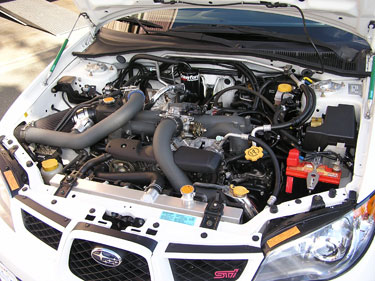Owning a High Horsepower Subaru
Owning a High Horsepower Subaru

Here at Fine Line Imports we regularly build 400-500WHP cars for customers who use them for both road racing (all-out track car), or a very fast street car. What tends to get overlooked once these cars leave Fine Line Imports, is the need for proper maintenance and upkeep in order to make sure your high horsepower Subaru stays in tip-top shape. The following article will hopefully shed some light on the responsibility that comes with owning and driving one of these amazing cars.
What is the difference between a 500whp engine we build for a track car and one we build for a street car? The answer is: not a whole lot. Both engines are heavily modified in order to not only make that power, but make it reliably. The next question is: what’s the difference in maintaining a 500whp track car engine vs a 500whp street car engine? The best answer to that question is there is NO difference. If you are driving a high horsepower Subaru on the street, then to put it simply, you need to think of it as a race car minus the roll cage.
Below are some simple guidelines, and tips that will aid you in keeping your high horsepower Subaru running in good shape.
- Oil – This is the life blood of your engine. It does not matter what high quality parts your engine is built with if you consistently run low on oil. If you do this, your engine’s life span WILL be significantly reduced. Your average Subaru engine contains roughly 4.8 quarts of oil. Running even 1 qt low is a BIG deal. At least 50% of the cars we work on come in at least half a quart to a full quart low on oil. Every time you get gas, or before and after hard driving, check your oil.
- Coolant – This is just as important as oil. Without the proper level of coolant your engine will overheat, and could cause severe damage. If you overheat your car, at the very least, the engine comes out and new head gaskets need to be installed. Like your engine oil, I recommend you check it every time you get gas.
- Warm-up – I cannot stress this enough, if you have a built motor, or even a high horsepower Subaru running on the stock engine, warming up your car to operating temperature before driving is a must. Forged pistons – like the ones found in the engines we build here – grow once they start to warm up. If you drive the car hard before they have expanded to full size, you can and will see more oil consumption. Warming up your car not only applies to the engine, but the transmission as well. Before you start to drive the car hard, and while the car is warming up to operating temperature, run through the gears normally a few times to bring the transmission and rear-end fluid up to operating temperature as well.
- Driving the car in extreme temperatures – If you plan on driving your car hard during hotter weather, or on the race track with any consistency, an upgraded cooling system is a MUST. When driving or racing you car on a hot day (90+ degrees), your car’s oil and coolant temps can reach dangerous levels a lot faster than you may think. This is where an upgraded radiator and oil cooler come into play. If your car does not have these upgrades, I strongly recommend not driving the car hard under these circumstances. Catastrophic engine damage can occur if severe overheating happens.
- Engine RPM – Always be mindful of your engine’s current RPM. Cruising around town or on the freeway at a high engine RPM, not only wastes fuel, but puts more wear and tear on your engine and its components. If your car’s peak horsepower and torque are made below redline, consider shifting at that point instead of redline in order to put less stress on your engine.
- Fuel Quality – Gas quality is a VERY important factor. Not all brands of 91-octane are equal, with some being lower quality than others. In our area I have found that Union 76 and Chevron have more consistent levels of good 91-octane, from station to station. If you have been tuned by FLI, then there is a way to tell how good your fuel quality is in the car. During the tune, Miles Hechtman (lead tuner of FLI) will tell you if the fuel quality is good or bad, and give you the baseline of where the Dynamic Advance Multiplier is. The Dynamic Advance Multiplier is the overall umbrella of how much timing the ECU is adding on top of the main ignition map, and AVCS map. Miles creates the timing maps based on how good the fuel quality is in the car during the tune. After the tune, you can view the Dynamic Advance Multiplier under the Live Data option on your Version 2 AccessPort, and compare it to the day of the tune. Keep in mind that there are many other factors like intake air temperature, intake manifold temperature (heat soak), humidity, and altitude. Using good consistent fuel will lead to better fuel mileage, overall better performance, and engine safety.
While owning a high horsepower Subaru requires more maintenance and attention to detail than the average Subaru, this should not dissuade you from modifying your car. Following the simple tips above will greatly reduce wear and tear on your engine, and help keep your Subaru running trouble-free for many miles.

